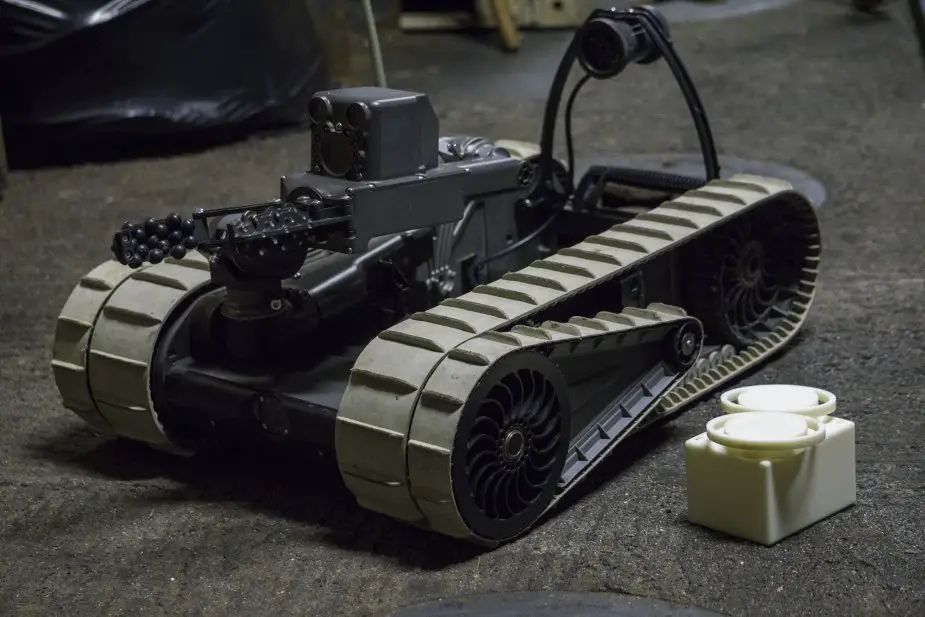Breaking news
3-D printer-capable Marines with 31st MEU print replacement part for F-35B.
Marines with Combat Logistic Battalion 31, 31st Marine Expeditionary Unit, are now capable of ‘additive manufacturing,’ also known as 3-D printing. This innovative technique is the process of replicating a digital 3-D model in the real world.

An iRobot 310 Small Unmanned Ground Vehicle belonging to Combat Logistic Battalion 31, 31st Marine Expeditionary Unit, sits staged with 3-D printed lens covers aboard the USS Wasp while underway in the Pacific Ocean, April 17, 2018. Marines with CLB-31 are now capable of ‘additive manufacturing,’ also known as 3-D printing, which is the technique of replicating digital 3-D models as tangible objects (Picture source : USMC)
3-D printing software breaks the digital model down into layers which can be reproduced by the printer. The printer then builds the model from the ground up, layer by layer, creating a tangible object.
The Marine Corps is all about mission accomplishment and self-reliance. From day one in boot camp recruits are taught to have a ‘figure-it-out’ mindset. 3-D printing is the next step for a Corps that prides itself on its self-sufficiency. CLB-31 uses its 3-D printer as an alternative, temporary source for parts. The purpose is to assist Marines with mission accomplishment in the face of hardship, such as mechanical parts failing.
As a permanently forward-deployed unit, it can be both crucial and difficult for the 31st MEU to get the replacement parts it needs for sustained operations. The 31st MEU’s mission - to deploy at a moment’s notice when the nation calls - is not conducive to waiting for replacement parts shipped halfway around the world. Capabilities like 3-D printing, which the 31st MEU can take with it when it deploys on Navy shipping, feed the MEU’s expeditionary mandate.
Proving this concept, Marine Fighter Attack Squadron 121 successfully flew an F-35B Lightning II with a part that was supplied by CLB-31’s 3-D printer, April 16, 2018. A VMFA-121 F-35B had a plastic bumper on a landing gear door wear out during the MEU’s Spring Patrol 2018. Though a small and simple part, the only conventional means of replacing the bumper was to order the entire door assembly – a process that is both time consuming and expensive. Utilizing a newly released process from Naval Air Systems Command for 3-D printed parts, the squadron was able to have the bumper printed, approved for use and flown within a matter of days – much faster than waiting for a replacement part to arrive from the United States.
VMFA-121 also made history in March as the first F-35B squadron to deploy in support of a MEU.
Making further use of the MEU’s 3-D printing capability, the MEU’s explosive ordnance disposal team requested a modification part that acts as a lens cap for a camera on an iRobot 310 Small Unmanned Ground Vehicle – a part which did not exist at the time. CLB-31’s 3-D printing team designed and produced the part, which is currently operational and is protecting the drone’s fragile lenses today.
The templates for both the plastic bumper and lens cover will be uploaded to a Marine Corps-wide 3-D printing database to make them accessible to any unit with the same need.
As the Indo-Pacific region’s force-in-readiness, the 31st MEU continues to brainstorm new opportunities for its 3-D printer, such as aviation parts and mechanical devices that can be used to fix every-day problems. Though only in the beginning stages of development, the 31st MEU will continue to push the envelope of what 3-D printing can do in the continued effort to make the MEU a more lethal and self-sufficient air-ground-logistics team.


























